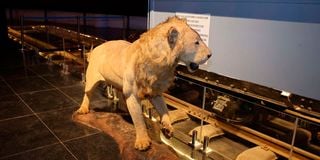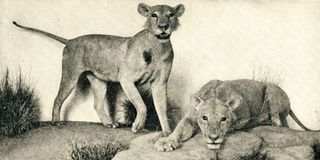
The Tsavo lions are known to have preyed on humans.
A study has revealed the hunting habits and the species of prey of the Man-Eaters of Tsavo, a notorious pair of lions that terrorised railway workers in Kenya in 1898.
The study, published in the Current Biology Journal, utilised advanced DNA analysis from hair samples found in the lions’ dental cavities, offering a rare glimpse into the dietary preferences and ecological interactions of these historical predators.
The Tsavo lions, known for their unusual predation on humans, have fascinated public imagination for over a century.
A British engineer, Lieutenant Colonel John Henry Petterson, hunted down and killed these lions.
Their remains were subsequently transported to the United States, where they are currently displayed at the Field Museum of Natural History (FMNH) in Chicago.
Their fearsome reputation earned them the moniker "Man-Eaters," but the full extent of their diet remained largely a mystery—until now.
In a remarkable scientific endeavour, researchers aimed to identify their dietary preferences.
To achieve this, the researchers compiled a list of potential prey species' mitogenomes using complementary approaches, including metagenomic profiling of hair, microscopy of hair, and historical accounts of species ranges.
They also extracted DNA from hair samples compacted within the cavities of the lions’ broken teeth.
This innovative method focused on optimising techniques for degraded DNA, allowing for the identification of various prey species consumed by the lions.
Metagenomic classification resulted in 27 potential species, and microscopy analysis yielded 16 potential species.
Using known species ranges and historical accounts, the researchers narrowed this list to 22 potential prey species eaten by lions in the Tsavo region during the 1890s.
Preyed on humans
The findings were both intriguing and enlightening, highlighting the lions' dietary preferences from over a century ago.
“Based on the comparative analysis of the depth (X) and breadth (%) of coverage for each species relative to other species in the mtDNA reference database, we inferred that the Tsavo lions consumed giraffe, human, oryx, waterbuck, wildebeest, and zebra,” the researchers said, revealing a diverse menu that these cats enjoyed at the time.

The Tsavo lions, known for their unusual predation on humans, have fascinated public imagination for over a century.
“The Tsavo lions are known to have preyed on humans. Hair 4 DNA matched the human mitogenome and showed characteristic deamination patterns typical of ancient/historical degraded DNA,” the research further concluded.
The researchers found that the lion mitogenome from a hair sample was identical to the Tsavo lion endogenous mitogenome and most closely matched other East African lions from Kenya and Tanzania.
“Our approach enables a better understanding of the hunting behaviours, diets, and ecology of historical individuals, populations, and species and holds promise for extinct populations and species,” said the researchers.
The findings of this research also reveal that identifying wildebeest as a prey species is intriguing, considering their historical distribution in the 1890s.
This suggests that Tsavo lions roamed larger geographic areas than previously believed, or that wildebeest were indeed present in the Tsavo region during that time.
The study offers evidence of the lions' intricate hunting behaviours and dietary preferences during a period when their environment was significantly different.
By analysing mitochondrial genomes (mitogenomes), the researchers achieved significant progress in understanding the ecological dynamics of the Tsavo lions.
The mitogenomic analysis highlighted that at least two of the giraffes consumed by the lions belonged to the Masai subspecies (Giraffa tippelskirchi tippelskirchi), native to southeast Kenya.
“The lions’ mitogenome matched closely with other East African lions, suggesting a familial link between these predators,” the research said.
Interestingly, the study revealed that the lions exhibited dental injuries, including broken canine teeth, which likely contributed to their prey-switching behaviours.
While they primarily hunted large herbivores, these dental issues and limited prey availability may have led them to pursue easier targets, including humans and livestock.
Historical records indicate that attacks on humans linked to the railway construction began in April 1898, and the two lions left the area between May and November 1898.
“It is possible that during their six months absence, lion 23969 traveled 90 km to a more productive environment with access to migrating herds of wildebeest and zebra,” the research said.
The results further underscored the lions' ecological adaptability. The research indicates that the presence of wildebeest as a prey species suggests that these lions may have roamed wider areas than previously thought.
Historical records indicate that the nearest grazing habitat for wildebeest from the Tsavo-Athi confluence, where the Tsavo “man-eaters” were killed in 1898, was about 90 km west, northwest, and south (toward the Tsavo River headwaters, the Athi River Basin, and the Kenya-Tanzania border).
“Our study indicates that the Tsavo lions’ diet included both grazers (zebra) and browsers (giraffe), with at least one lion (FMNH 23970) preying on humans (hair 4). Prey-switching can be further investigated through the genomic analysis of stratigraphic layers of hair in the tooth cavities, with hair from the bottom of the cavity representing initial prey captured earlier in life, and hair at the surface of the cavity representing more recent prey,” the study say.
Notably, the study’s authors approached the identification of human remains with sensitivity and care.
“Now that we have confirmed human remains in this project, we refrain from using this information to predict ancestry and linked ethnicities of the person to whom this hair belonged,” they said.
The reason given for this is that data analysis only traces one of many ancestral lines of this person and the scarcity of sampling in Africa.
“The anthropological methods require discussions with local institutions and groups about the project as well as reporting the detailed human colonial history of this geographic region, which is beyond the scope of this current study,” they said.
The Taita Taveta residents and local leaders have been advocating for the repatriation of these cat remains from the US to Kenya to generate revenue for the country. The remains have become the most popular exhibits at a museum in the US, attracting millions of tourists each year.
The Tsavo lion specimens were collected in December 1898 and sent to Roland Ward's taxidermy studios in London for preparation. The skulls were incorporated into the skins, which were fashioned into 'trophy rugs.' They arrived at the FMNH in 1925 and were dismantled from their original preserved state.
The skulls were removed, and the skins were re-tanned and mounted without the original skulls inside.
The skulls were placed into storage boxes and kept in the FMNH mammal research collection, where they remained until 1996 when they were put on display next to the mounted skins.









